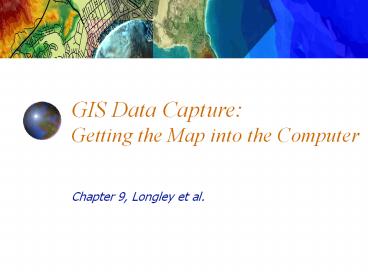GIS Data Capture: Getting the Map into the Computer - PowerPoint PPT Presentation
Title:
GIS Data Capture: Getting the Map into the Computer
Description:
– PowerPoint PPT presentation
Number of Views:91
Avg rating:3.0/5.0
Title: GIS Data Capture: Getting the Map into the Computer
1
GIS Data CaptureGetting the Map into the
Computer
2
Overview
- Introduction
- Primary data capture
- Secondary data capture
- Data transfer
- Capturing attribute data
- Managing a data capture project
- Error and accuracy
3
Data Collection
- Can be most expensive GIS activity
- Many diverse sources
- Two broad types of collection
- Data capture (direct collection)
- Data transfer
- Two broad capture methods
- Primary (direct measurement)
- Secondary (indirect derivation)
4
Data Collection Techniques
Field/Raster Object/Vector
Primary Digital remote sensing images GPS measurements including VGI
Primary Digital aerial photographs Survey measurements
Secondary Scanned maps Topographic surveys
Secondary DEMs from maps Toponymy data sets from atlases
5
Stages in Data Collection Projects
6
Primary Data Capture
- Capture specifically for GIS use
- Raster remote sensing
- e.g., SPOT and IKONOS satellites and aerial
photography, echosounding at sea - Passive and active sensors
- Resolution is key consideration
- Spatial
- Spectral, Acoustic
- Temporal
7
(No Transcript)
8
Vector Primary Data Capture
- Surveying
- Locations of objects determines by angle and
distance measurements from known locations - Uses expensive field equipment and crews
- Most accurate method for large scale, small areas
- GPS
- Collection of satellites used to fix locations on
Earths surface - Differential GPS used to improve accuracy
9
Total Station
10
GPS Handhelds
text
geographic coordinates
photos
video
audio
Bluetooth, WiFi
11
Power to the PeopleVGI PPGIS
- Volunteered Geographic Information
- Wikimapia.org
- Openstreetmap.org
- Public Participation GIS
- GEO 599, Fall 2007
- dusk.geo.orst.edu/virtual/
12
Example A Boon for International Development
Agencies
Kinshasa, Democratic Republic of Congo
Robert Soden, www.developmentseed.org
13
International Development, Humanitarian Relief
Mogadishu, Somalia
Robert Soden, www.developmentseed.org
14
Citizen Sensors
UCLA Center for Embedded Networked Sensing,
http//peir.cens.ucla.edu
15
Societal Issues(privacy, surveillance,
ethics)e.g., Google StreetView
Early and late May 2008
16
More surveillance (electronic, video, biological,
chemical) integrated into national system
From Chris Peterson, Foresight Institute As
presented at OSCON 2008, Portland
17
From Chris Peterson, Foresight Institute As
presented at OSCON 2008, Portland
Graphic Gina Miller
18
Sewer monitoring has begun
The test doesnt screen people directly but
instead seeks out evidence of illicit drug abuse
in drug residues and metabolites excreted in
urine and flushed toward municipal sewage
treatment plants.
From Chris Peterson, Foresight Institute As
presented at OSCON 2008, Portland
19
Secondary Geographic Data Capture
- Data collected for other purposes, then converted
for use in GIS - Raster conversion
- Scanning of maps, aerial photographs, documents,
etc. - Important scanning parameters are spatial and
spectral (bit depth) resolution
20
Scanner
21
Vector Secondary Data Capture
- Collection of vector objects from maps,
photographs, plans, etc. - Photogrammetry the science and technology of
making measurements from photographs, etc. - Digitizing
- Manual (table)
- Heads-up and vectorization
22
Digitizer
23
GEOCODING
- spatial information ---gt digital form
- capturing the map (digitizing, scanning)
- sometimes also capturing the attributes
- mapematical calculation, e.g.,
- address matching
WSW
24
Managing Data Capture Projects
- Key principles
- Clear plan, adequate resources, appropriate
funding, and sufficient time - Fundamental tradeoff between
- Quality, speed and price
- Two strategies
- Incremental
- Blitzkrieg (all at once)
- Alternative resource options
- In house
- Specialist external agency
25
The Role of Error
- Map and attribute data errors are the data
producer's responsibility, - GIS user must understand error.
- Accuracy and precision of map and attribute data
in a GIS affect all other operations, especially
when maps are compared across scales.
26
Accuracy
- closeness to TRUE values
- results, computations, or estimates
- compromise on infinite complexity
- generalization of the real world
- difficult to identify a TRUE value
- e.g., accuracy of a contour
- Does not exist in real world
- Compare to other sources
27
Accuracy (cont.)
- accuracy of the database accuracy of the
products computed from database - e.g., accuracy of a slope, aspect, or watershed
computed from a DEM
28
Positional Accuracy
A useful rule of thumb is that positions measured
from maps are accurate to about 0.5 mm on the
map. Multiplying this by the scale of the map
gives the corresponding distance on the ground.
29
Positional Accuracy (cont.)
- typical UTM coordinate pair might be
- Easting 579124.349 m
- Northing 5194732.247 m
- If the database was digitized from a 124,000 map
sheet, the last four digits in each coordinate
(units, tenths, hundredths, thousandths) would be
questionable
30
Testing Positional Accuracy
- Use an independent source of higher accuracy
- find a larger scale map
- use GPS
- Use internal evidence
- digitized polygons that are unclosed, lines that
overshoot or undershoot nodes, etc. are
indications of inaccuracy - sizes of gaps, overshoots, etc. may be a measure
of positional accuracy
31
Precision
- not the same as accuracy!
- repeatability vs. truth
- not closeness of results, but number of decimal
places or significant digits in a measurement - A GIS works at high precision, usually much
higher than the accuracy of the data themselves
32
Accuracy vs. Precision
33
Accuracy vs. Precision
34
Components of Data Quality
- positional accuracy
- attribute accuracy
- logical consistency
- completeness
- lineage
35
Midterm
36
Midterm
- Multiple choice on scantron/bring 2 pencil
- Major concepts moreso than details
- PPT files, lecture notes, Chapters 1, 3-4, 9, 20
in Longley et al. - Will not include
- Web Sites of the Week (WSWs)
- Labs
- Learning Assessment/Practice Questions on class
web site































